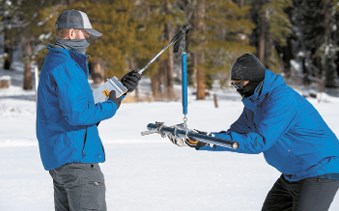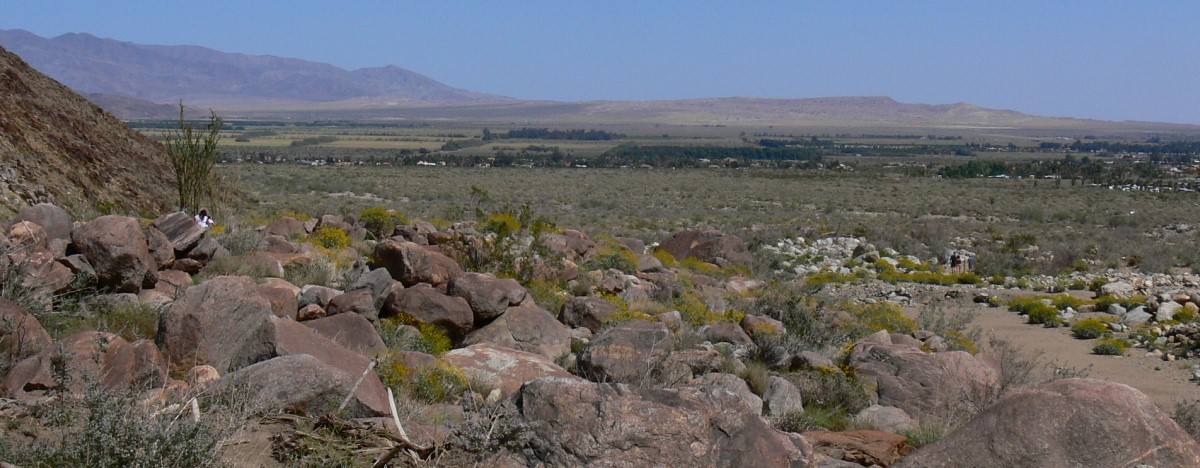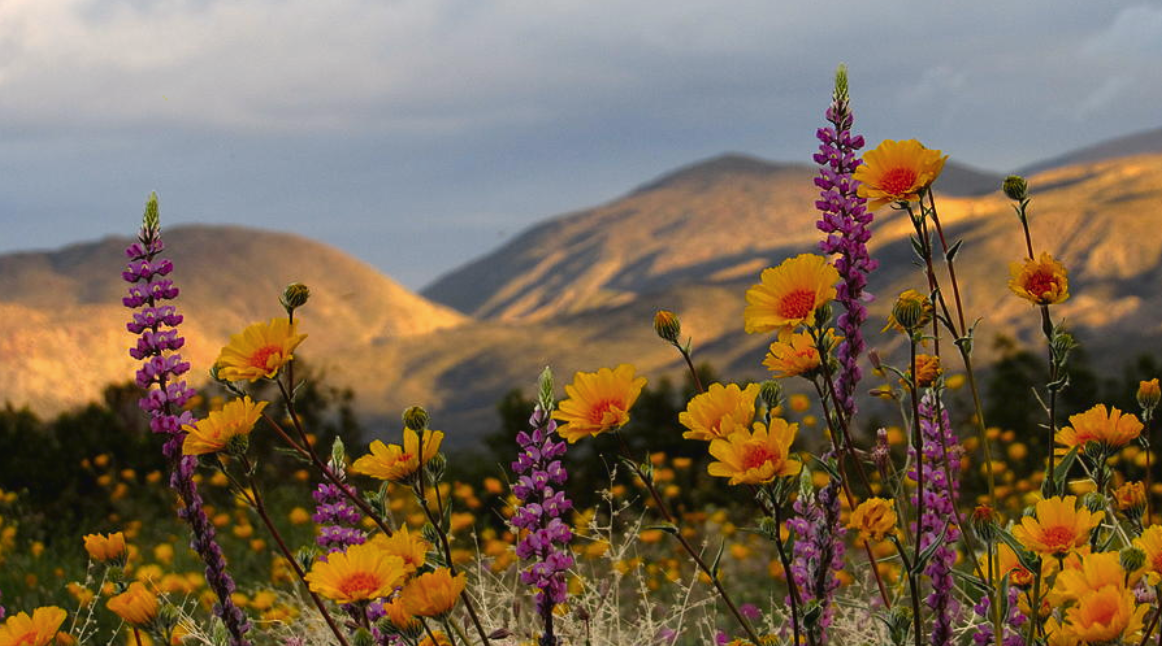In California water news this weekend …
‘Fossil water’ may be vanishing from California
“A dinosaur bone. The footprint of a woolly mammoth. An ancient shell imprinted on a rock in your backyard. These are the images the word “fossil” calls to mind. But, buried deep within the earth, there’s another kind of fossil you might not expect — ancient aquifers, created by rain and snow that fell more than 10,000 years ago. And unless the fossil water stores are better protected, scientists say, they may become a thing of the past. New research on fossil water from Lawrence Livermore National Laboratory suggests that drinking wells that pump fossil water can’t rely on it being replenished — especially during times of drought. … ” Read more from the San Jose Mercury News here: ‘Fossil water’ may be vanishing from California
Dry conditions to persist for weeks as window to make up for arid winter starts closing
“In recent weeks, meteorological models gave the Bay Area a glimmer of hope that some much-needed precipitation was on its way, bringing a bit of relief to a parched region. But those hopes — like much of California itself — have dried up. The Bay Area and most of the Golden State are bracing for several more rain-free weeks, adding to what has already been an abnormally dry rainy season, meteorologists said. “That’s been the pattern this winter so far,” said Anna Schneider, a National Weather Service meteorologist. … ” Read more from the San Francisco Chronicle here: Dry conditions to persist for weeks as window to make up for arid winter starts closing
 Farmers make crop plans amid dry early winter
Farmers make crop plans amid dry early winter
“With the winter off to a dry start, farmers say they’re making contingency plans for tight water supplies, while retaining hope that storms in the first three months of 2021 will bolster the Sierra Nevada snowpack and reservoir storage. When the California Department of Water Resources conducted its first manual snow survey last week, DWR officials found snow at 93% of average at an El Dorado County location—but elsewhere, the Sierra snowpack lags much further below normal. Statewide, the snowpack stands at about half of average for the date. … ” Read more from Ag Alert here: Farmers make crop plans amid dry early winter
California North Coast farmers fear dry winter amid dismal snow survey
“The slow drip from Mother Nature’s faucet so far this winter has caused cautious concern from farmers and their bureaus reliant on adequate water supplies. After surveying the Sierra Nevada snowpack on Dec. 30, the California Department of Water Resources reported 52% of the statewide average in comparison to this time last winter. The mountain range’s snowpack — referred to as the state’s “frozen reservoir” — supplies about 30% of California’s water needs. The lack of water in this given winter is not good news for farmers. ... ” Read more from the North Bay Business Journal here: California North Coast farmers fear dry winter amid dismal snow survey
Q&A: ‘Informed communities build healthier communities’
Niketa Kumar writes, “Through our ongoing series on broadening who makes water decisions and how, we connected with Miguel Hernandez, communications coordinator at Comite Civico del Valle, on his team’s partnership with communities surrounding the Salton Sea. Water Foundation (WF): Hi, Miguel. To start us off, how does Comite Civico del Valle support community power building? Miguel Hernandez (MH): Comite Civico del Valle (CCV) strongly believes that informed communities build healthier communities. Therefore, one of the strongest strategies to support community power is by ways of educating and informing community members about relevant concerns that impact their quality of life and engage them to be part of the discussions. … ” Read more from the Water Foundation here: Q&A: ‘Informed communities build healthier communities’
Legal brief: CEQA does not limit agencies’ authority to impose mitigation pursuant to other laws
“CEQA does not constrain an agency’s authority to administer and enforce any other laws, including those authorizing imposition of mitigation requirements. Thus, even after an EIR for a project has been certified, a regional water board, as a responsible agency, can impose additional mitigation on the project through waste discharge requirements (WDRs) issued under the Porter-Cologne Water Quality Control Act. Santa Clara Valley Water District v. San Francisco Bay Regional Water Quality Control Board, No. A157127, 2020 WL 7706795 (Cal. Ct. App. Dec. 29, 2020). ... ” Read more from the California Land Use and Development Law Report here: CEQA does not limit agencies’ authority to impose mitigation pursuant to other laws
SPECIAL SECTION: What’s next for the community of Borrego Springs and the future of Borrego’s water and land-use planning?
Borrego Springs – Southern California, but a World Apart
“Amidst drought, groundwater regulation, and economic hardship, the media portrays Borrego Springs as a village “drying up” in the desert – running out of water – soon to be the next California ghost town. Like many aspects of the desert, there’s more to the Borrego Springs community than meets the eye. In the crevices of the valley’s rocky floor, wildflowers blossom in exuberant hope. In the shade of the Palo Verde trees, Coyote Creek babbles through the sandy slopes with perseverance. From corner to corner, the community is banding together: evaluating how to live within the constraints of this remote locale, charting a course that integrates civic engagement with environmental, social and economic priorities – to achieve their goal of a thriving, resilient future. This is their story. … ” Read more from the Local Government Commission here: Borrego Springs – Southern California, but a World Apart
Saving Borrego’s Lifeblood
“Borrego Springs’ only viable water source is a large aquifer under Borrego Valley; it has long been accepted that the aquifer’s water collected over millennia and is being pumped at a rapid pace by recent generations. What farmers, developers, business owners, and residents never agreed upon was how much water was actually available, and how long it would last.” Read more from the Local Government Commission here: Saving Borrego’s Lifeblood
Community Voices
“LGC, with the help of five Stanford University students, conducted interviews with community members to understand varying perspectives and identify where community visions overlap in order to help guide the community on a path forward. Ten Borregans lent their voices to these interviews, including full-time residents, commuters, and weekenders.” Read more from the Local Government Commission here: Community Voices
Borrego’s Path to Resilience in the Face of Change
“As a new year begins, Borrego Springs is eager for opportunities to ensure community resilience while protecting the local economy and the region’s precious ecosystems. In the face of many obstacles, not all hope is lost. This article wraps up the four-part series, highlighting the revitalization of the Borrego Valley Stewardship Council and their efforts to pave the way for a brighter future.” Read more from the Local Government Commission here: Borrego’s Path to Resilience in the Face of Change
IMAGE CREDIT: Photo of Borrego Springs by Jim Mullhaupt
California budget …
 STATE BUDGET: Governor Newsom submits budget proposal with funding included for wildfire and forest resilience, sustainable groundwater management, habitat restoration, and flood management
STATE BUDGET: Governor Newsom submits budget proposal with funding included for wildfire and forest resilience, sustainable groundwater management, habitat restoration, and flood management
Governor Gavin Newsom today submitted his 2021-22 State Budget proposal to the Legislature totaling $227.2 billion. Here are some of the highlights pulled from the climate change, sustainable agriculture, natural resources, and environmental protection chapters. … ” Read more from Maven’s Notebook here: STATE BUDGET: Governor Newsom submits budget proposal
Here’s how Newsom’s proposing to spend $4.1 billion on the climate and environment
“The $227 billion budget proposed on Friday by Gov. Gavin Newsom includes $4.1 billion in spending on a suite of environmental initiatives meant to fight climate change, gird California against devastating wildfires, reduce smog, and bolster the adoption of clean vehicles on the state’s roads. Given the pandemic-induced recession, the fact that California has so much to spend on the environment is remarkable, but the state is looking at a $15 billion surplus thanks to a progressive tax structure that helped capture huge capital gains generated by a soaring stock market. … ” Read more from KQED here: Here’s how Newsom’s proposing to spend $4.1 billion on the climate and environment
Newsom’s budget calls for investment in prescribed fire to combat catastrophic blazes
“Following a record wildfire season in California, Gov. Gavin Newsom wants to invest an additional $1 billion to make the state’s forests and communities more resilient to future blazes. The bulk of the money, detailed in a far-reaching budget proposal released Friday, would go toward improving the health of California’s wildlands by preemptively burning and thinning dangerous buildups of vegetation — to ensure that the landscape won’t burn as catastrophically as it has in recent years. … ” Read more from the San Francisco Chronicle here: Newsom’s budget calls for investment in prescribed fire to combat catastrophic blazes
In regional water news this weekend …
Klamath dam removal historic result of local activism
““The Klamath River is the center of our traditions, culture and community, and has always been the centerpiece of our way of life,” says Frankie Myers, vice-chairperson for the Yurok Tribe. “We are connected to the salmon in a really deep way, and there is a belief that their existence is our existence.” The Yurok people have lived in the 15,700 square miles Klamath River Basin, in what is now called Northern California, for millennia. They are among the key organizers in a coalition of Indigenous groups, environmentalists, concerned citizens and commercial fishers that have joined forces in a decades-long movement to Un-dam the Klamath. … ” Read more from LA Progressive here: Klamath dam removal historic result of local activism
 No more flooding threat to Jenner as mouth of Russian River opens
No more flooding threat to Jenner as mouth of Russian River opens
“Water levels at the coastal mouth of the Russian River had declined by late Thursday afternoon, eliminating the threat of flooding in the town of Jenner, according to a release from Sonoma Water, the county water agency. High waves pounded the Sonoma Coast for days, creating a large mound of sand that sealed the mouth of the river. The waves’ intensity initially kept Sonoma Water from sending a heavy equipment operator to dig a channel that would release the water from the river into the ocean. … ” Read more from the Santa Rosa Press Democrat here: No more flooding threat to Jenner as mouth of Russian River opens
Pure Water Monterey project bolstered by federal grant
“Recognizing the groundbreaking nature of the Pure Water Monterey recycled water project, the U.S Department of the Interior’s Bureau of Reclamation has awarded the project a $15.5 million grant. Under its WaterSMART initiative, which seeks to invest in technologies designed to enable “broader scale use of recycled water to supplement supplies,” the federal Bureau of Reclamation awarded the local recycled water project nearly 40% of its $40 million in grants awarded after a competitive review process, according to a release. … ” Read more from the Monterey Herald here: Pure Water Monterey project bolstered by federal grant
Eastern Tule Groundwater Sustainability Agency approves $22,000 contribution to Water Blueprint for the San Joaquin Valley
“On Thursday afternoon, the Eastern Tule Groundwater Sustainability Agency’s (ETGSA) Authority Board of Directors hosted a meeting over Zoom, and as part of the agenda the ETGSA approved a contribution to Water Blueprint for the San Joaquin Valley (WBSJV) to identify water supplies in the amount of $22,000. WBSJV has been working to identify the water supplies that might be available to achieve water sustainability in the San Joaquin Valley, including the Tule Subbasin. … ” Read more from the Porterville Recorder here: Eastern Tule Groundwater Sustainability Agency approves $22,000 contribution to Water Blueprint for the San Joaquin Valley
Ventura’s water security requires investment now, says Susan Rungren, General Manager of Ventura Water
She writes, ” … To maintain essential services and protect our water resources, Ventura must continually invest in our water and wastewater systems. Investments will allow us to improve water quality, replace old pipelines and aging infrastructure, meet regulatory requirements, and secure water supply for the future. The city has a two-pronged approach to address our critical water supply challenges: recycle the water we already have and access additional water supplies through the State Water Project. … ” Read more from the Ventura County Star here: Ventura’s water security requires investment now, says Susan Rungren, General Manager of Ventura Water
San Bernardino: How to sign up for virtual water-education classes
“San Bernardino Valley Municipal Water District has teamed up with the Inland Empire Resource Conservation District to provide free water education via virtual class presentations and supplemental materials for parents and teachers. These water education offerings are available for kindergarten through12th-grade students, and each presentation has been adapted with the Next Generation Science Standards in mind, according to a news release. … ” Read more from the San Bernardino Sun here: How to sign up for virtual water-education classes
Authority certifies environmental report for Los Cerritos wetlands restoration
“A study detailing environmental impacts of restoration efforts at the Los Cerritos Wetlands (LCW) was unanimously certified Thursday, Jan. 8, by the LCW Authority. The Program Environmental Impact Report (PEIR) covers an overview or conceptual plan for restoration. Mark Stanley, LCWA executive director, said specific restoration projects still will require completion of another EIR before going forward. … ” Read more from the Grunion here: Authority certifies environmental report for Los Cerritos wetlands restoration
Indio resident joins effort to keep Lake Cahuilla from closing when county’s lease expires in March
“Julian Rangel is on a mission: Keep Lake Cahuilla and all its recreational amenities open for public use and help the county and water district work out a new lease before the current agreement expires in March. “We’re just trying keep the local family outdoor recreation, the only one (like it that) we have here, open,” said Rangel, of Indio, an electrician and founder of Desert Valley Outdoors – a group of local citizens who donate time and knowledge about hunting, fishing and other outdoor activities with kids and families and anyone else who is interested. ... ” Read more from the Desert Sun here: Indio resident joins effort to keep Lake Cahuilla from closing when county’s lease expires in March
In people news this weekend …
Ag remembers conservation champion Rich Rominger
 “Farm groups remember fifth-generation California farmer Richard Rominger as a leader in conservation agriculture and environmentally sound farming practices who was also a champion for agriculture in federal and state government. Rominger, a former Deputy Secretary of Agriculture under President Bill Clinton from 1993-2001 and former state Secretary of Food and Agriculture, died in December. He was 93. His family’s Rominger Brothers Farms, a 6,000-acre operation in Winters that produces processing tomatoes and other commodities, is considered a model of conservation agriculture, recently receiving the Aldo Leopold Conservation Award. ... ” Read more from the Western Farm Press here: Ag remembers conservation champion Rich Rominger
“Farm groups remember fifth-generation California farmer Richard Rominger as a leader in conservation agriculture and environmentally sound farming practices who was also a champion for agriculture in federal and state government. Rominger, a former Deputy Secretary of Agriculture under President Bill Clinton from 1993-2001 and former state Secretary of Food and Agriculture, died in December. He was 93. His family’s Rominger Brothers Farms, a 6,000-acre operation in Winters that produces processing tomatoes and other commodities, is considered a model of conservation agriculture, recently receiving the Aldo Leopold Conservation Award. ... ” Read more from the Western Farm Press here: Ag remembers conservation champion Rich Rominger
Alameda County Water District General Manager to retire
“After 30 years of service with the Alameda County Water District and over six years as General Manager, Robert T. Shaver has announced his retirement from ACWD effective July 1, 2021. Under Shaver’s leadership, ACWD efficiently: administered a $175 million annual operating and capital expense budget; responsibly managed local and imported water supplies guiding the District out of the historic drought ending in 2017; reached near completion of the District’s largest infrastructure investment to date with the construction of fish passage projects in Alameda Creek; and launched an Advanced Metering Infrastructure program that will allow the District to engage more effectively with customers and help ACWD continue its leadership in water use efficiency. … ” Read more from ACWA’s Water News here: Alameda County Water District General Manager to retire
Podcasts …
INGRAINED PODCAST: An incredible journey multiplied by 1.2 million
It’s a miraculous journey done every year. An estimated 1.2 million snow geese are part of the annual Pacific Flyway migration, traveling thousands of miles as they head south for the fall and winter. Fortunately, the Sacramento Valley provides just what is needed for these boisterous birds to rest and refuel. Rice fields provide more than 60 percent of the fall and winter diet for these hearty travelers, as well as the flocks of migrating ducks. More resources here.
WATER TABLE PODCAST: Permaculturist Brock Dolman
Brock Dolman is a biologist and systems thinker. He is the co-founder of Occidental Arts and Ecology Center—one of the first permaculture education centers in North America. In this episode, Brock colorfully muralizes the concept of regenerative hydration by connecting tools like rainwater, greywater, and fog harvesting, with conceptual tools like water budgets and unorthodox partnerships with keystone species, like the beaver. Brock wants us to think of watersheds as a lifeboat, where we not just slow it, spread it, sink it, but think it, too.
WATER IS A MANY SPLENDOR’ED THING PODCAST: The Perspective from an Eye in the Sky
 Steve Baker writes, “What started out as research of gravity fields using satellites turned into the discovery of satellite data noise that was a signal that was coming from water. Water is a Many Splendor’ed Thing brings you another water relationship that has a personally significant impact to your life.” Produced by Steven Baker, Operation Unite® Bringing People Together to Solve Water Problems, Online at www.operationunite.co
Steve Baker writes, “What started out as research of gravity fields using satellites turned into the discovery of satellite data noise that was a signal that was coming from water. Water is a Many Splendor’ed Thing brings you another water relationship that has a personally significant impact to your life.” Produced by Steven Baker, Operation Unite® Bringing People Together to Solve Water Problems, Online at www.operationunite.co
In national water news today …
Progress – but too little – on toxic lead water pipes, say Timothy Male & Sridhar Vedachalam with the Environmental Policy Innovation Center
“In 2018 the US Environmental Protection Agency declared a “war on lead” by investing in infrastructure to eliminate the country’s lead water pipes “within a decade”. Towards that end the Trump administration last month introduced a new regulation that would see the replacement of lead pipes. Here, Timothy Male and Sridhar Vedachalam explain that while this is a step in the right direction, it’s simply not enough. The rule will not achieve the goal of eliminating lead pipes in a generation. … ” Read more from the Global Water Forum here: Progress – but too little – on toxic lead water pipes
What’s in that water? ‘Geochemical Santa Claus’ offers new data to climate modelers
“For many years scientists thought that groundwater — which hides in underground aquifers and slowly makes it way out to sea — wasn’t adding much to ocean chemistry. After all, groundwater only makes up a small percentage of the global freshwater flowing into the sea. But a new study in the journal Nature Communications finds that there’s a lot more chemicals flowing through groundwater into the ocean than previously thought. That new data should help researchers make better models of Earth’s past and future climate. … ” Read more from WBUR here: What’s in that water? ‘Geochemical Santa Claus’ offers new data to climate modelers
 Record number of billion-dollar disasters struck U.S. in 2020
Record number of billion-dollar disasters struck U.S. in 2020
“It was an extraordinary year for weather and climate events in the U.S.: The nation endured an unprecedented 22 billion-dollar disasters in 2020. A record number of named tropical storms formed in the Atlantic, with a record 12 making landfall. The nation also had its most active wildfire year on record due to very dry conditions in the West and unusually warm temperatures that gripped much of the country. Here’s a recap of the climate and extreme weather events across the U.S.in 2020, according to scientists at NOAA’s National Centers for Environmental Information. … ” Read more from NOAA here: Record number of billion-dollar disasters struck U.S. in 2020
Catch up on last week’s news in the Weekly Digest …
WEEKLY WATER NEWS DIGEST for Jan 3-8: Public benefits of conveyance projects, Carbon capture in the Delta, Climate change impacts on CA water supplies, all this week’s top news stories, and more …
Also on Maven’s Notebook this weekend …
FUNDING: Ten Conservation Practices Prioritized for Accelerated Funding in California
NOTICE: NRCS announces extended application deadline for California wildfire disaster recovery funding
FEATURED IMAGE by Sicco Rood http://www.siccorood.com
SNOW SURVEY photo by DWR
JENNER/RUSSIAN RIVER photo by North Bay Wanderer



